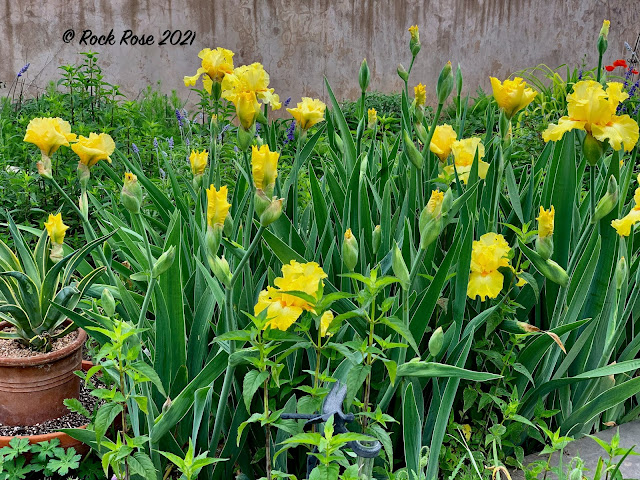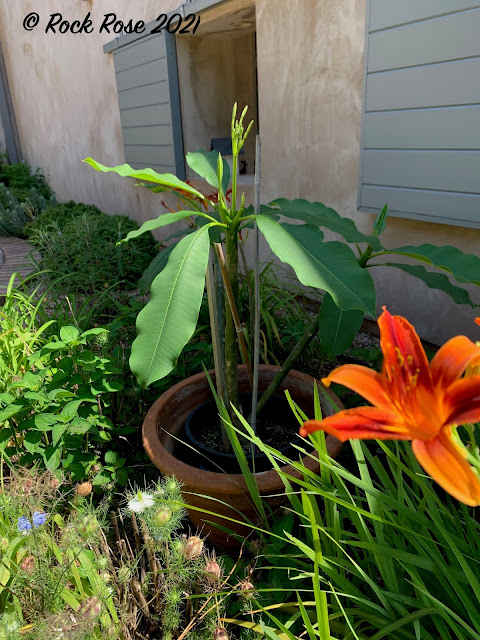I often ask myself when I am out in the garden, "Who would win if I just let the garden take care of itself." Would it become a mono-culture or would every year bring a different winner. I think maybe the latter and I say this because I often say, "It's been a really great year for such and such a plant" I think mother nature gives every plant a chance.
This year the cone flowers, Echinacea purpurea, would take the prize.
They were busy preparing for this year last year when they set hundreds of seeds-which, of course, I allowed to remain. And I am not really sorry because I think they just look marvelous. I wish they would last a little longer although I suppose the idea is to let something else take center stage. They have even muscloed their way into the English garden. Of course as often happens they are right by the stepping stone instead of in the more open spaces.
And who among this group would take over. Mulleins, gopher plants, blanket flowers or wine cups. Each one of them would vie for top dog position in the garden.
Naturally the weather plays a big part on what will bloom successfully in each season. We had a relatively dry winter and then all hell let lose with one of the deepest freezes, in fact the deepest freeze I have experienced while living in Texas. It wiped out a number of plants, in particular the larger ones. Maybe some of them were ready to go. I had a gorgeous Pride of Barbados that had volunteered in the small strip between sunken garden and pool. Over a period of 5 years, despite dying back to the ground every winter, its girth increased with every year.
It was really too big for the space but that deep freeze did something I couldn't bring myself to do and that was remove it. But the good news is it left behind some offspring. One a little further along and one in the middle of the sunken garden. Maybe they will be too young to flower this year but I am excited that in the future they will. And in a prior year one grew between two rocks on the other side of the sunken garden. Maybe it was sheltered between those rocks and that was why it survived or maybe the covering of ice and snow helped insulate it. It does seem to be the smaller plants that survived.
Let's look at Monarda 'Peter's Purple' Is there a more successful spreader than this plant? It isn't that it seeds but that it sends its underground runners out in all directions to make new plants. One year it managed to successfully invade the yellow iris. How charming, I thought, when the iris finish here comes the bee balm. That is until the iris failed to bloom the following year, completely crowded out by bee balm. Then the bee balm decided to move out and this year the iris bloomed with a mighty vigor chasing the bee balm in its relentless spread.The bee balm is so adored by all manner of flying insects and hummingbirds too that I don;t have much of a problem letting it go on its merry way.
My beautiful Philippine violets, Barleria cristata, took a big hit. The two along the edge of the pathway(volunteers) in the Sunken garden are slowly making their way back but the big one has split itself into four plants leaving a gaping hole in the center. It is a perfect place to add a pot and it so happens that last winter an arm broke off the plumeria, which I potted up and is growing.
One plant that is not permitted in the back gardens is the Engelmann daisy, Engelmannia peristenia. I can remember when I bought 3 small 4" plants at the Wildflower Center sale. "Oh! you'll have plenty of those" someone said. Now I have more than even I could have imagined and I constantly pull them out-not an easy propositions as they send down a big successful taproot. That is why they do so well in dry gardens . But they are beautiful when in bloom in the early morning. By afternoon their yellow petals have curve under. They do give the garden a somewhat wild appearance.
And that was before the American beautyberry, Callicarpa americana, and the liatris, Liatris spicata. started to move in. I think the latter might be the most freely seeding plant in Texas. At least in my garden. It does add gorgeous color in the later months of the year.
But of course I am not going to let any one of these plants the chance to take over. I leave that to the next gardener who lives here.



































5 comments:
All these plants contribute to the beauty of your garden but it also sounds as though they also take significant effort to control. The nearest equivalents I have are Barleria obtusa and Erigeron karvinskianus. I can't even imagine Echinacea reseeding here, much less offering a display like that.
Three years ago, I planted three 4" Maximillian sunflowers in my rain garden. Now I have hundreds, perhaps a thousand. They take up a third of that garden bed. And I know there's more on the way, since last year's seedlings are still small, as is the habit of perennials.
Today I read that they are allelopathic. OH NO!
I had already been planning on paring them down to half of their current distribution, but now I'm not sure I want any in that bed at all. There are other plants I want to save, and new ones I want to try.
But they're so pretty, with both handsome foliage throughout spring and summer and tall blooms that wave and lend drama in fall. Not much else in my garden blooms then, either. They're iconic of fall for me.
I think I must keep some. I'm anxious about whether I'll even be able to rip them out effectively, though. I have some sort of not-very-ornamental wild Gaura that runs rampant there too, which I made progress on eradicating this spring, but half of what I pulled seems to have returned.
Beautiful pictures as usual! My coneflowers are also putting on quite a show here in North Texas. There are so many, I won't feel bad cutting them to the ground when they start to get unsightly.
The Pride of Barbados is in bloom around my part of SoCal now too. I can't seem to make this plant work in my crowded garden ;) It really needs an open area around it to best appreciate it. So cool that you've got seedlings of it! I'm in awe of your stand of echinacea. In my own garden, very little would live after spring if left on its own -- except for the agaves and other succulents. The poppies will return every spring, probably Verbena bonariensis, centranthus/valerian, Erodium triflorum, maybe the chocolate flower/berlandiera, horned poppies/glaucium, feather grass if I let it get established. Very interesting question! And your garden is showing amazing resilience after that extreme cold event.
I attended a webinar by Fergus Garrett on 'Gardening the Great Dixter Way' this past week and was struck by something he said. The garden is allowed to find it's way. We just step in when it gets lost." I think that aptly describes most gardens.
Post a Comment